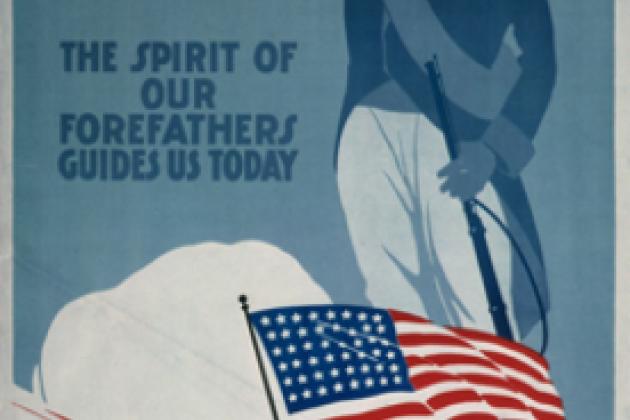- History
- Military

Repercussions of quantitative changes in military forces are relative strictly to those forces’ specific missions and deployments. By itself, the reduction of U.S. forces envisaged by the 2014 Quadrennial Defense Review—of roughly five percent across the board—does not change their capacity to perform any of the missions entrusted to them. Nor would an increase of similar size do so. History confirms military logic: Battles are won or lost by forces that get there “fustest with the mostest”—by forces that establish superiority in specific places at specific times. How to do that should be the question at hand.
A glance at the number of U.S. combat units, ships, and aircraft, as well as where they are forward-deployed around the world in defensive positions, is suggestive of a climber whose extremities are fully spread to tenuous toe-and-finger holds on a vertical rock, and for whom movement in any direction is perilous. (See Anthony H. Cordesman, The FY2015 Defense Budget and the QDR: Key Trends and Data Points, pages 40-47.)
Now as ever in history, the key to success lies less in the overall size of forces than in their location and above all in the strategy that matches specific forces to specific missions.
Size
In 415 B.C. the Athenian Assembly debated and approved a proposal by Alcibiades to send an expedition of some sixty triremes—without hoplite infantry—to Sicily to support the local Segestans and Leontines, with the hope of leading an alliance of Sicilian cities to conquer Syracuse—a major pro-Spartan power. In a subsequent meeting of the Assembly, Nicias opposed the expedition arguing that it would require a much larger force. The Athenian people did not balk at size or cost. They sent over a hundred high quality ships and 5,000 hoplite infantry, all lavishly equipped to conquer Syracuse by surprise and storm. But this armada’s failure to accomplish this was not due to any lack of size or quality, but rather to lack of cavalry. Nicias had not asked for that key element. Athenian forces, then left besieging Syracuse, found themselves gradually enveloped by a counter-expedition of Spartans and allies. In each of the following two years, Athens sent reinforcements—the last consisting of 73 ships and 5,000 more hoplites under Eurymedon and Demosthenes. But doubling the Athenian force did not change its senseless situation: The small harbor in which the ships were operating rendered useless the high tech qualities that would have allowed them to dominate the high seas, and made it possible for the enemy to defeat them with barges. More hoplites could no more storm defended walls than a smaller number. Because the Athenians were applying the wrong forces in the wrong place, size and quality did not matter. Trapped, the Athenians lost their fleet and a total of some 40,000 men. Never again would the Athenian navy be mistress of the sea, nor Athens enjoy secure land borders.
However, forces smaller than the enemy’s by factors estimated variously between 3 to 1 and over 10 to 1 had not prevented the Athenians from utterly defeating the Persians on the plain of Marathon in 490 B.C. The smaller force triumphed because quality and tactics were properly adapted to the situation. The Athenians and their Plataean allies having blocked the land exit from the beach where the larger Persian army had landed and having shielded their flanks against its cavalry, waited for an opportunity. That seems to have come when, apparently, the Persian cavalry was absent. At that point, Herodotus tells us, the Greeks attacked at a run. Their phalanx kept its order as it enveloped the Persian mob-in-arms. Pressed on three sides and unable to break through, the Persians fled and were slaughtered.
Athens’ deployment of its army to Marathon had staked all—just as ten years later, its retreat to the island of Salamis where a naval force much smaller than Persia’s saved the city had staked all. But there had been no other choice.
Location
History suggests, however, that staking all by fighting the nation’s main battles far away from home is not a good idea. Consider Rome. In 218 and 217 B.C. Hannibal inflicted on Rome the three worst defeats in the Republic’s history. Rome lost some 30,000 men at the Trebia river in Lombardy, and again on the shores of Lake Trasimene in Umbria. Then, at Cannae in Apulia, Rome lost twice that number along with a substantial part of its aristocracy.
Machiavelli argues in Book II Chapter XII of his Discourses that “had the Romans suffered in Gaul, and within the same space of time, those three defeats at the hands of Hannibal which they suffered in Italy, it must have made an end of them; since they could not have turned the remnants of their armies to account as they did in Italy, not having the same opportunity for repairing their strength; nor could they have met their enemy with such numerous armies.” The Roman Republic’s wise policy, says Machiavelli, was never to send more than fifty thousand or so legionnaires to fight far away. Thus, no defeat far away could be fatal, while the closer an enemy got to Rome, the greater was the force that Rome could muster. He also tells us that “against the inroad of the Gauls at the end of the first Carthaginian war, we hear of them bringing some eighteen hundred thousand men into the field.”
The contrast with late Roman imperial history could not be more stark: Rome’s legions were in garrisons on the empire’s edges. They fought one another rather than shift in mutual support against the barbarians. The city, left with forces fit primarily for partisan infighting and for holding down the population, became impotent and irrelevant.
Strategy
The 2014 QDR defines the mission of U.S. forces, spread as they are around the world, as: “Protect the homeland…deter and defeat attacks on the United States…Build security globally, in order to preserve regional stability, deter adversaries, support allies and partners, and cooperate with others to address common security challenges. Project power and win decisively, to defeat aggression, disrupt and destroy terrorist networks…” These are not statements of strategy, but wishes, unconnected with forces and plans sufficient for realizing them in the face of opposition.
This is not entirely new. Post World War II U.S. forces, their quantity growing or diminishing with the course of U.S. politics or world events, never had the means or the plans (above all, nor was there ever the political will) that would have allowed them forcefully to maintain “containment” by defeating a thrust at any point along the edges of the Communist world. The Korean War made this clear.
The Eisenhower administration, realizing that the U.S. did not have the forces to seal the Communist empire’s edges, and that trying to acquire such power would militarize American society, declared that it would respond to challenges to its peripheral deployments with “massive retaliation at times and places of our own choosing.” The peripheral forces became “trip wires.” Given the efficiency of nuclear forces (“more bang for the buck”), this made sense in principle. But what would happen if the wires were tripped? Senator J.W. Fulbright charged that Eisenhower and Secretary of State John Foster Dulles were bluffing, challenging them to specify where and how they might redeem this pledge and how they might deal with the consequences.
Dulles’ retreat into “we do not discuss hypotheticals” and “all options are on the table” supported Fulbright’s charge. Then, when the Kennedy-Johnson administration dismantled U.S. air defenses and banned attempts to defend the country against ballistic missile attack, the possibility that the U.S. might use serious force against a serious power by eliminating the capacity of dealing seriously with the consequences thereof vanished. The Vietnam War proved that.
Because—rhetoric and billions of dollars in the service of tokenism notwithstanding—the U.S. government in the Twenty-First Century is still not serious about defending America against missile attack; because, averse as it is to disproportionate force, it is more un-serious about deterrence than ever, it makes as little sense as ever to consider our peripherally deployed forces as “trip wires.” Hence, definitions of the mission of U.S. forces such as those of the 2014 QDR are as liable to Fulbright’s questions as was the Eisenhower-Dulles doctrine: Just how are you going to do that with what you’ve got and where you’ve got it?
How?
“Build security globally, in order to preserve regional stability, deter adversaries, support allies and partners…” Give or take ten or twenty percent of current U.S. forces, as deployed and organized, given current operational doctrine, what is the U.S. government prepared to do, say, to prevent the Western Pacific from becoming a Chinese lake or to prevent the growing legions of Muslim terrorists from striking America?
In case China were to declare the Taiwan Strait to be sovereign waters and occupy the islands therein, or were it to sink Philippine ships that entered into its newly declared economic zone in the South China Sea and declare that U.S. ships would be sunk were they to enter into such areas without permission, how and with what could the U.S. Navy re-establish our rights in the Pacific as well as affirm the independence of the islands therein?
What difference would it make were the U.S. to send two aircraft carriers or four? These technical marvels, fit to dominate the middle of the ocean, would be vulnerable in narrow seas. China has made reasonable preparations for sinking them there. Supposing they were sunk. How would the U.S. government deal with their loss? Supposing the carriers avoided being sunk. What would their aircraft destroy that would fix the problem? Are there means or plans for dealing with China’s reaction in a way that would “protect the homeland?” These questions have no good answers.
Deter and protect, you say? Suppose that a dozen terrorists whose last address was the new Islamic State in what had been Syria-Iraq, or whose last address was Iran or the Palestinian territories, decided to roll suitcase bombs simultaneously into the security lines of a dozen major U.S. airports or to throw Molotov cocktails into a dozen school buses, or to destroy a dozen major U.S. electrical transformer stations: How does anyone think that current U.S. forces, intelligence included, might stop them? What incentive are these forces poised to give to the governments of such states that might lead them to stop such people from striking America? What would the U.S. government do to whom after such outrages that might prevent them from happening again? Would it, yet again, send hundreds of thousands of U.S. troops to nation-build those states while using drones to kill some individuals who someone convinced our intelligence agencies are terrorists? The U.S. government has done that, and it has not worked out so well.
In sum, questions about the size of the U.S. military pale in importance next to ones about how its units, currently spread out and barely able to maintain themselves against serious opposition, might be reconfigured and redeployed to provide a surfeit of force to overwhelm whatever objectives the country might require for its safety.
The size of a snake is less relevant than whether it is stretched out, or coiled to strike.















